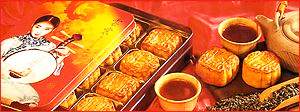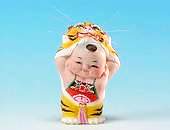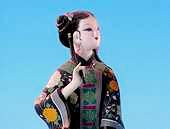 |
| The Chinese Moon Festival |

The Chinese Moon Festival, or sometimes called the Mid-Autumn Festival, takes place on the 15th day of the eighth lunar month. The festival dates back to the Tang dynasty 618 AD and celebrates the biggest and brightest full moon of the year, the harvest moon.
As with many Chinese celebrations, there are ancient legends to explain the holiday. In ancient times, the Chinese planted and harvested by the lunar calendar, using the moon as an important time reference and guide.
 The Moon Festival is a big holiday with family reunions and moon gazing activities. The Moon Festival is a big holiday with family reunions and moon gazing activities.
In mid-autumn, farmers have just finished gathering their crops and bringing in fruits from the orchards. They are overwhelmed with joy when they have a harvest and at the same time, they feel quite relaxed after a year of hard work. So the 15th Day of the eighth lunar month has gradually evolved as a widely celebrated festival for ordinary people. Night falls. The land is bathed in silver moonlight. Families set up tables in their courtyards or sit together on their balconies, chatting and sharing offerings to the moon. Together, they enjoy the spell of night. Naturally, they are reminded of beautiful legends about the moon. The most popular one tells how a goddess named Chang'e ascended to the moon.
 One of the legends about the Moon Festival is about a builder or architect named Hou Yi and his divinely beautiful wife, Changer. Hou Yi built a beautiful jade palace for the Goddess of the Western Heaven or sometimes called the Royal Mother. The Goddess was so happy that she gave Hou Yi a special pill that contained the magic elixir of immortality. But with it came the condition and warning that he may not use the pill until he had accomplished certain things. However, one day Changer found the pill and without telling her husband, she swallowed it. The Goddess of the Western Heaven was very angry and as a punishment, Changer was banished to the moon where, according to the legend, she can be seen at her most beautiful on the night of the bright harvest moon. One of the legends about the Moon Festival is about a builder or architect named Hou Yi and his divinely beautiful wife, Changer. Hou Yi built a beautiful jade palace for the Goddess of the Western Heaven or sometimes called the Royal Mother. The Goddess was so happy that she gave Hou Yi a special pill that contained the magic elixir of immortality. But with it came the condition and warning that he may not use the pill until he had accomplished certain things. However, one day Changer found the pill and without telling her husband, she swallowed it. The Goddess of the Western Heaven was very angry and as a punishment, Changer was banished to the moon where, according to the legend, she can be seen at her most beautiful on the night of the bright harvest moon.
A special cake is eaten during the mid-autumn festival, called the moon cake. The making of moon cakes dates from the Tang dynasty (618 -907). During the Ming dynasty it was the custom to exchange moon cakes as greetings at family reunions and it was during the Qing dynasty that the moon cakes found today (a cake usually stuffed with walnut paste) was established. The ingredients used in moon cakes do however differ from area to area in China. Those of Suzhou are similar to shortbread and have several layers containing bean paste, ginkgo spiced salt or meat, usually pork. Beijing moon cakes are stuffed with vegetables, while Chaozhou ones are oily and very sweet. Cantonese moon cakes are oil-rich and have lots of stuffing inside little dough. They can be stuffed with coconut paste, lotus seed paste, various fruits, seeds and nuts, egg yolk, chicken, ham or date paste.
|
|
|













